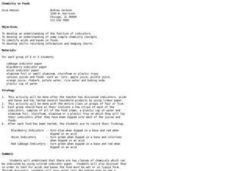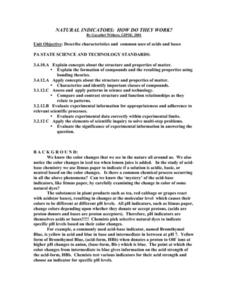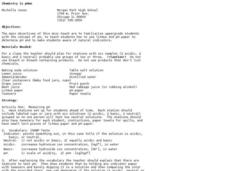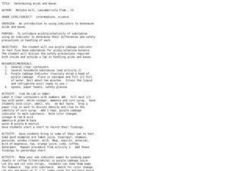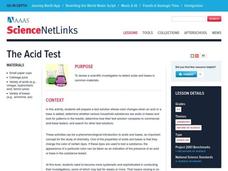Curated OER
Chemical Magic
Students identify acids and bases. In this chemistry lesson, students use red cabbage juice as an indicator of whether the liquid is an acid or base. Students discuss the results.
Curated OER
Mystery Powder Lab
In this mystery powder instructional activity, students determine the identify of 6 unknown samples by testing them with cabbage juice for pH, vinegar, iodine for starch and heat. Students determine the identity of the mystery powders...
Curated OER
Making A Natural pH Indicator
Students make their own pH indicator from red cabbage. Red cabbage contains a chemical that turns from its natural deep purple color to red in acids and blue in bases. Students boil the cabbage to get the pH indicator.
Curated OER
Acid (and Base) Rainbows
Students are introduced to the differences between acids and bases and how to use indicators, such as pH paper and red cabbage juice, to distinguish between them. They make predictions that can be answered through scientific...
Curated OER
Chemistry in Foods
Students investigate foods that are indicators, and acids and bases. In this food chemistry lesson plan, students test household products with litmus paper and with food indicators. They use blackberry, onion and red cabbage indicators...
American Chemical Society
Chemistry Color Changers
Knowledge of acids and bases doesn't need to be a secret. Learners use red cabbage to create an indicator solution, then test how adding lemon juice (acid) and detergent (base) changes the color of the solution. They then use the concept...
US Environmental Protection Agency
Corals and Chemistry
After demonstrating the use of cabbage juice as a pH indicator, have your class experiment with their own breath, exhaling into the indicator, to show that carbon dioxide is acidic. As learners work, they also watch a video about coral...
Curated OER
The Colors of Chemistry
Students investigate the acidity and alkalinity of common household products in an experiment. They use red cabbage juice and litmus paper to show the difference between strong acids and bases as they work with vinegar, dish washing...
Curated OER
Natural Indicators: How Do They Work?
Young scholars describe characteristics and common uses of acids and bases. They describe the role of natural indicators in the chemistry of acids and bases after testing and making observations on a variety of plant extracts. Students...
Curated OER
Investigating Acidity
Learners classify liquids as an acid, base or neutral. They use purple cabbage juice as an indicator to test several liquids in order to group them as acids, bases or neutrals.
Curated OER
An Introduction to Acids and Bases
Students explore acids and bases. In this lesson about acids and bases, students do an experiment to test certain items to determine what they are. Students use cabbage and litmus paper as indicators. Students understand how to sort the...
Curated OER
Household Acids and Bases
Ninth graders complete an experiment to determine the pH values of a variety of common household substances. They use red cabbage to find the indicator colors of the pH range. They complete a data table that includes a prediction and...
Curated OER
Sometimes, solid + liquid = gas
Third graders experiment with common household liquids and solids. In this chemical reaction lesson, 3rd graders discuss phase changes and experiment to find other ways to create gases. They use water, vinegar, lemon juice, flour, baking...
Curated OER
Determining Acids and Bases
Young scholars test various liquids and identify as acids or bases. In this chemistry and pH lesson, the students use purple cabbage indicator to test a variety of teacher-provided substances, then bring in liquids from home to test...
Curated OER
Chemistry is pHun
High schoolers investigate the pH of solutions and they learn how to use different types of indicators. In this pH lesson plan, students test various solutions with pH paper and determine if they are acidic, basic or neutral. They also...
Teach Engineering
Basically Acids
Base your lesson plan on acids and bases on an informative resource. The first installment of a five-part module on the science behind Harry Potter has individuals investigate acid/base chemistry with the use of invisible inks. They also...
Curated OER
Determining Acids and Bases
Students use purple cabbage indicator to test five know substances for acidic/alkaline balance. They discuss the safety precautions required both inside and outside a lab in handling acids and bases.
Curated OER
Determining pH
Students evaluate pH levels through a solubility experiment. In this pH levels lesson, students list characteristics of acids and bases. Students complete their own pH level experiment. Students go to the GEMS Alien Juice Bar website to...
Curated OER
The Acid Test
Students prepare a test solution whose color changes when an acid or a base is added. They determine whether various household substances are acids or bases and look for patterns in the results. Students determine how their test solution...
Curated OER
Mixtures
Sixth graders experiment with mixtures. In this chemistry activity, 6th graders determine which mixtures are considered heterogeneous, a suspension, a solution or a colloid. Students create a data sheet of what they discover.
Curated OER
HOW IS PH DETERMINED?
Students estimate the pH based on the use of an unknown substance, determine whether an unknown substance is acid, base or neutral, and evaluate, by the pH determination, which of the unknowns is the strongest acid or base.
Curated OER
The Heat is On!
Fifth graders investigate evidence for changes in matter that occur during a chemical reaction.
Curated OER
Pandemics and Epidemics
Students evaluate data related to population growth, along with problems and soultions: disease cvontrol. They are able to explain how changes in habitat may affect organisms. Students evaluate evolutionary theories and processes.
Curated OER
Stomach Chemistry
Fifth graders compare physical and chemical changes. They perform a simulation experiment/activity that replicates what happens in the stomach as food is digested by stomach acids.






